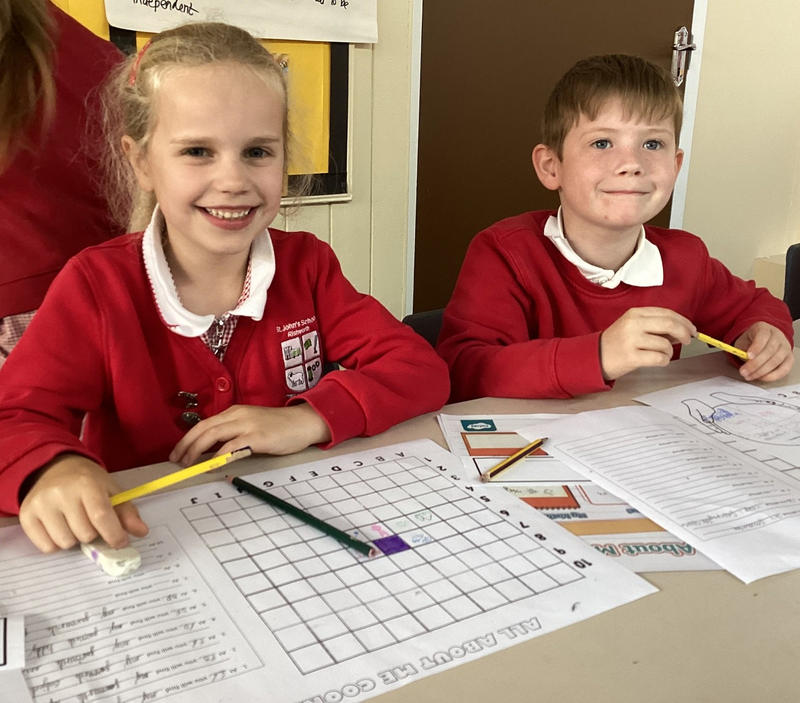Mathematics at St John’s
Mathematics teaches us how to make sense of the world around us through developing a child’s ability to calculate, to reason and to solve problems. It enables pupils to understand and appreciate relationships and pattern in both number and space in their everyday lives. Through their growing knowledge and understanding, pupils learn to appreciate the contribution made by many cultures to the development and application of mathematics.
Mathematics is a core subject in the National Curriculum, and we use this as the basis for implementing the requirements of the programme of study for mathematics.
The aims of mathematics at St John’s are:
· to promote enjoyment and enthusiasm for learning through practical activity, exploration and discussion;
· to promote confidence and competence with numbers and the number system;
· to develop the ability to solve problems through decision-making and reasoning in a range of contexts;
· to develop a practical understanding of the ways in which information is gathered and presented;
· to explore features of shape and space, and develop measuring skills in a range of contexts;
· to apply mathematical skills across the curriculum and understand the importance of mathematics in everyday life.
INTENT
· 1. Self – We want to foster a sense of mathematical curiosity in our pupils so they persevere in order to deepen their understanding.
· 2. Others – We want our pupils to learn to work co-operatively with others to solve practical maths problems.
· 3. Wider world – We believe maths is an essential part of everyday life, providing a foundation for understanding the world, critical to science, technology, engineering and finance.
IMPLEMENTATION

The school uses a variety of teaching and learning styles in mathematics lessons. With every teacher trained in the White Rose Maths mastery approach, we move the pupils gradually from concrete to pictorial to abstract approaches. When introduced to a new concept, pupils should have the opportunity to build competency by taking the following approach:
Concrete – The ‘doing’ stage
Bringing concepts to life by allowing pupils the experience of handling physical objects.
Pictorial – The ‘seeing’ stage
Encouraging pupil to visualise and draw representations of concrete experiences which then provides a link to the abstract.
Abstract – The ‘symbolic’ stage
Using mathematical symbols to model and solve problems.
Our principal aim is to develop and deepen pupil’s knowledge, skills and understanding in mathematics. In our daily maths lessons, we encourage pupils to ask as well as answer mathematical questions. The pupils work on a variety of fluency, reasoning and problem-solving questions. They have the opportunity to use a wide range of concrete resources such as counters, numicon, number lines, number squares, digit cards and small apparatus to support their work. Pupils use computing in mathematics lessons where it will enhance their learning, as in modelling ideas and methods. Wherever possible, we encourage the pupils to use and apply their learning across the curriculum and in everyday situations.
In all classes there are pupils of differing mathematical ability. We recognise this fact and provide suitable learning opportunities for all pupils by matching the challenge of the task to the ability of the child. We achieve this through a range of strategies – for example: in some lessons through differentiated work, and in other lessons by organising the pupils to work in pairs on open-ended problems, investigations or games. We use classroom assistants to support some pupils and to ensure that work is matched to the needs of individuals.
Follow the links to view the White Rose Maths Schemes of Learning for each year group.
https://whiterosemaths.com/resources/early-years-resources/reception-sol/
https://whiterosemaths.com/resources/primary-resources/primary-sols/




Follow the links to view the
White Rose Maths Calculation Policies used at school:
| Name | Format | ||
|---|---|---|---|
| Files | |||
| multiplication-and-division-calculation-policy-july-2022.pdf | |||
| wrm-addition-subtraction-calculation-policy-july-2022.pdf |
Follow the links to view the
White Rose Maths Yearly overviews
for each year group:
| Name | Format | ||
|---|---|---|---|
| Files | |||
| reception.pdf | |||
| year-1.pdf | |||
| year-2.pdf | |||
| year-3.pdf | |||
| year-4.pdf | |||
| year-5.pdf | |||
| year-6.pdf |









